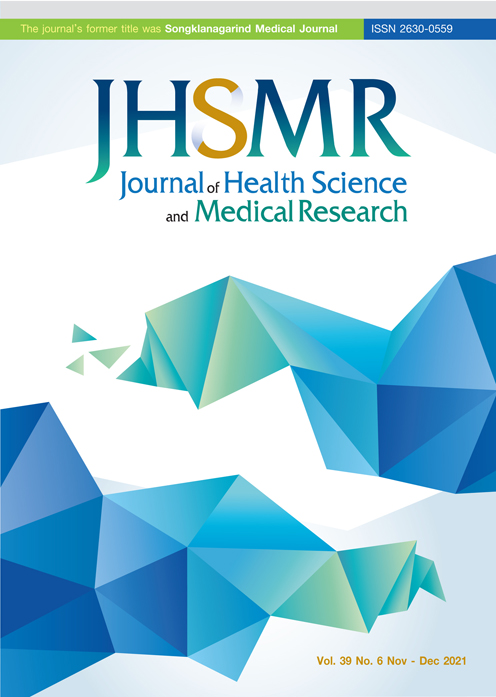Comparison Between the Effectiveness of Mental Practice and Physical Practice using Cup Stacking on Hand Function in the Elderly
DOI:
https://doi.org/10.31584/jhsmr.2021809Keywords:
elderly, hand function, mental practice, physical practice, stacking cupsAbstract
Objective: The objective of this study was to investigate the effect of mental vs. physical cup stacking practice in healthy people aged over 65 years.
Material and Methods: Healthy elderly, who met the inclusion criteria, were randomized into 2 groups—physical practice and mental practice. Both groups received cup stacking training according to the specific condition of the group. This study collected data on the immediate effects of the training using the Jebsen Hand Function Test (JHFT) for both hands, the dominant and the non-dominant ones. The movement time during cup stacking and reaction time were measured. The paired t-test and the independent t-test were selected to analyze the differences within and between groups, respectively.
Results: There were 39 participants in each group. It was found that the movement time related to stacking cups and the JHFT movement time of the non-dominant hand was significantly lower in the physical practice group compared with the mental practice group. Besides, after training, the movement time for stacking cups and the JHFT movement time of both hands was significantly lower in both groups. However, a statistically nonsignificant result for reaction time was found in the mental practice group after training.
Conclusion: This study shows that both mental and physical training can enhance the ability to learn hand movement in the elderly. In further studies, the inclusion of the retention of training effects after practice, a different training approach, and a feedback method should be considered.
References
Dop.go.th. Older statistics [homepage on the Internet]. Bangkok: Department of Older Persons [cited 2019 Oct 13]. Available from: http://www.dop.go.th/th/know/1
Maes C, Gooijers J, Orban de Xivry JJ, Swinnen SP, Boisgontier MP. Two hands, one brain, and aging. Neurosci Biobehav Rev 2017;75:234-56.
Carmeli E, Patish H, Coleman R. The aging hand.J Gerontol Series A 2003;58:146-52.
Miyawaki T, Kumamoto K, Shimoda K, Tozato F, Iwaya T. Relationship among motor function, ADL disability, and psychological concerns in elderly people with locomotive disorders. J Orthop Sci 2017;22:339-44.
Giorgio A, Santelli L, Tomassini V, Bosnell R, Smith S, De Stefano N, et al. Age-related changes in grey and white matter structure throughout adulthood. NeuroImage 2010;51: 943-51.
Sullivan EV, Pfefferbaum A. Neuroradiological characterization of normal adult ageing. Br J Radiol 2007;80:S99-108.
Salat DH. The declining infrastructure of the aging brain. Brain Connec 2011;1:279-93.
Bloom F, Beal F, Kupfer D. The Dana Guide to Brain Health. New York: Simon & Schuster; 2003.
Hart MA, Bixby WR. Brain activation patterns during participation in cup stacking. RQES 2005;76:A57.
Jeannerod M. Mental imagery in the motor context. Neuropsychologia 1995;33:1419-32.
Feltz DL, Landers DM. The effects of mental practice on motor skill learning and performance: a meta-analysis. J Sport Exerc Psychol 1983;5:25-57.
Saimpont A, Malouin F, Tousignant B, Jackson PL. Motor imagery and aging. J Mot Behav 2013;45:21-8.
Gentili RJ, Papaxanthis C. Laterality effects in motor learning by mental practice in right-handers. Neuron 2015;297:231-42.
Sanders C, Sadoski M, Bramson R, Wiprud R, Walsum K. Comparing the effects of physical practice and mental imagery rehearsal on learning basic skills by medical students. AJOG 2004;191:1811-4.
Tretriluxana J, Taptong J, Chaiyawat P. Dyad training protocol on learning of bimanual cup stacking in individuals with stroke: effects of observation duration. J Med Assoc Thai 2015;98:S106-12.
Cameron MH, Monroe L. Physical rehabilitation: evidencebased examination, evaluation, and intervention. St. Louis: Elsevier Health Sciences; 2007.
Saimpont A, Malouin F, Tousignant B, Jackson PL. Motor imagery and aging. J Mot Behav 2013;45:21-8.
Coffman DD. Effects of mental practice, physical practice, and knowledge of results on piano performance. J Res Music Educ 1990;38:187-96.
Shumway-Cook A, Woollacott MH. Motor control: translating research into clinical practice. Maryland: Lippincott Williams & Wilkins; 2007.
Liu H, Song LP, Zhang T. Mental practice combined with physical practice to enhance hand recovery in stroke patients. Behav Neurol 2014;2014:876416.
Alikhani H, VaezMousavi M, Mokhtari P. The effect of cognitive and motivational imagery on choice reaction time. World Appl Sci J 2011;12:792-6.
Abourezk T, Toole T. Effect of task complexity on the relationship between physical fitness and reaction time in older women. J Aging Phys Act 1995;3:251-60.
Husseini F, Damirchi A, Babaei P. Effect of brain training on cognitive performance in elderly women diagnosed with mild cognitive impairment. Caspian J Neurol Sci 2016;2:25-31.
Light KE, Reilly MA, Behrman AL, Spirduso WW. Reaction times and movement times: benefits of practice to younger and older adults. J Aging Phys Act 1996;4:27-41.
Downloads
Published
How to Cite
Issue
Section
License

This work is licensed under a Creative Commons Attribution-NonCommercial-NoDerivatives 4.0 International License.
























